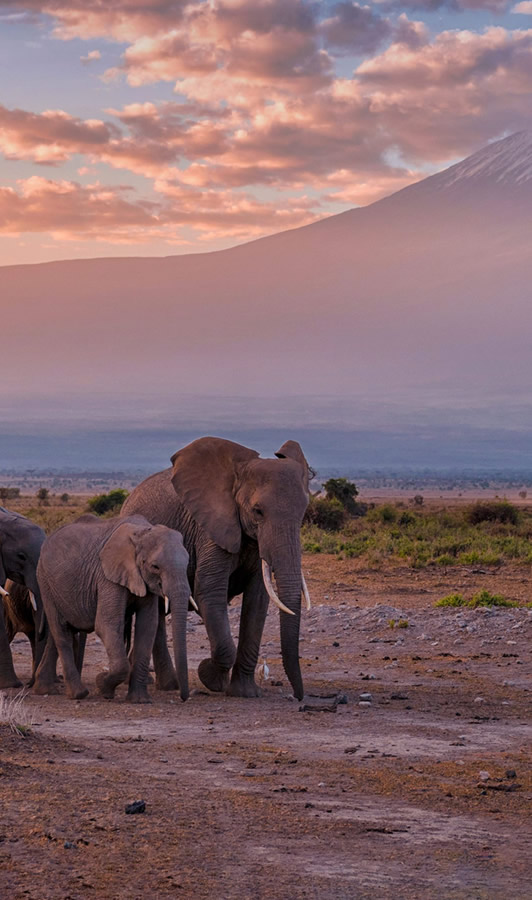Introducing
Amboseli National Park
Amboseli is a land of wide dry plains with the vistas stretching to the farthest horizon to become one with the sky. It is dotted with green swamps among semi-arid plains of acacia trees and grasses where great herds of elephants rule the land. The park is renowned for its elephant population - large, tusked bulls, of which the most iconic Tim, a huge elephant with tusks reaching the ground. The stunning backdrop of the tallest African mountain, Kilimanjaro in Tanzania, makes Amboseli a darling for photographers and filmmakers. Amboseli is considered Kenya‘s biosphere reserve. The name Amboseli in Maa (Maasai language) means place of water, and it reveals its true nature. In its swamps live huge herds of elephants, as well as lions, leopards, and cheetahs.
Against a backdrop of looming Mount Kilimanjaro, you can see everything from lush primaeval swamps to wide, dry plains here. ‘Amboseli’ is an English corruption of the Maa word Empusel, meaning ‘salty, dry place’ but underground streams flowing from the melting ice cap on Kili keep certain areas of the park well supplied with water, which in turn attracts elephants and plenty of birds. Parts of the forested swamp have been fenced off to prevent elephants from munching their way through the trees and to allow the vegetation time to regrow. During the long rains between about March and April, the dry plain can become a shallow lake, filled with wading birds (there are 400 species here alone). Because it is quite small, Amboseli is easy for rangers to patrol and is very well kept.
Highlights
Large herds of elephant are a common sighting at the Amboseli National Park
Set on the backdrop of Mount Kilimanjaro
Great Birding Destination with over 400 recorded bird species
Kenya's premier park with diverse wildlife concentrations
Amboseli National Park is a darling destination for photographers and filmmakers
Diverse accommodation and safari activities
Wildlife Viewing:
Amboseli National Park
The diversity of the landscape is reflected in the diversity of the game. Elephants are commonly sighted and many are known by name by the guides because they’ve been studied by researchers at the Amboseli Elephant Research Centre. There is also a baboon research centre here to find out more about these very social, inquisitive and intelligent primates. We can’t guarantee the Big 5 in Amboseli: leopard and rhino are virtually non-existent here. But don’t let that deter you as they are easily found elsewhere in Kenya (Lewa is fantastic for rhino and the Masai Mara for leopard). You won’t see the weirdly proportioned gerenuk either as they prefer the aridness of Samburu in the north.
But you should see masses of birdlife, bat-eared foxes (a very rare sighting), giraffe, lion, buffalo, cheetah, and non-migrating wildebeest. For getting your game-spotting eye ‘in’, Amboseli is ideal. Look out for Thomson’s gazelle and how they differ from impala; Maasai giraffe; Burchell’s or plains zebra; and plenty of spotted hyena (known as ‘spotties’ – there are no brown hyena here).

Best time to visit:
Amboseli National Park
Animals can be found in the park year-round, but July to October offers the best weather conditions for game drives. November to February is considered the best time for bird watching due to migration patterns. March to May is the long rainy season in Kenya. Conditions for game drives are not good, and the chances of sightings are lower. However, the country is incredibly beautiful this time of year, with all the flowers in full bloom.
How to get to:
Amboseli National Park
Amboseli National Park sits near the Kenyan-Tanzanian border in the south of Kenya. It is a four to five-hour journey from Nairobi by car covering 240km, or seven to eight hours by car if you are travelling from Mombasa and through Tsavo West National Park. You can also take a domestic flight from Wilson airport into the airstrip at Amboseli. It is also accessible from Arusha in Tanzania if you are hopping the border to continue your African adventure from Kilimanjaro.











